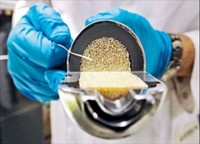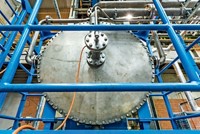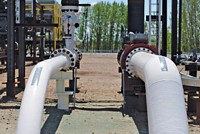Advertisement
Grab your lab coat. Let's get started
Welcome!
Welcome!
Create an account below to get 6 C&EN articles per month, receive newsletters and more - all free.
It seems this is your first time logging in online. Please enter the following information to continue.
As an ACS member you automatically get access to this site. All we need is few more details to create your reading experience.
Not you? Sign in with a different account.
Not you? Sign in with a different account.
ERROR 1
ERROR 1
ERROR 2
ERROR 2
ERROR 2
ERROR 2
ERROR 2
Password and Confirm password must match.
If you have an ACS member number, please enter it here so we can link this account to your membership. (optional)
ERROR 2
ACS values your privacy. By submitting your information, you are gaining access to C&EN and subscribing to our weekly newsletter. We use the information you provide to make your reading experience better, and we will never sell your data to third party members.
Climate Change
Carbon Clean launches modular CO₂ capture system
The firm says its CycloneCC takes up one-tenth the space and operates at half the cost of conventional approaches
by Craig Bettenhausen
November 11, 2021

The carbon capture firm Carbon Clean has launched an off-the-shelf CO2 capture system that it says can capture the greenhouse gas for $30 or less per metric ton. The company is one of several betting that the future of carbon capture will include small, modular systems in addition to the large custom ones in operation today.
The new system, CycloneCC, captures carbon with a specialized amine-based solvent in a rotating packed-bed reactor. Amine-based solvents are the most widely deployed chemistry for carbon capture today. In such systems, gas streams containing CO2 are pumped through a contact chamber, where the CO2 dissolves and reacts with the solvent. In a separate chamber, heat and vacuum pull the now-concentrated CO2 back out of the solvent. The solvent is then cooled and cycled back into the contact chamber.
The rotating packed-bed setup maximizes contact between the solvent and the CO2-laden gas stream, allowing the equipment to be one-tenth the size of the dripping solvent towers used in conventional amine-solvent carbon capture, the firm says. In addition to the smaller footprint, Carbon Clean says its system will cost half as much to buy and run as custom-built tower-based systems do.
CEO Aniruddha Sharma and cofounder Prateek Bumb started Carbon Clean in 2009 and have raised around $45 million from investors including the cement maker Cemex and the energy companies Equinor and Chevron. Cemex plans to be the first customer for CycloneCC, starting with a module that can capture 100 metric tons (t) per day at its site in Rüdersdorf, Germany. Carbon Clean is going to market with 10 t and 100 t modules and hopes to add standard sizes up to 300 t.
Carbon Clean is pursuing a different part of the market than many other carbon capture technology providers. Its small, modular system is suited to industrial sites such as chemical plants that have several smaller emissions plumes, rather than to facilities like power plants with a few large pipes.
The units are currently made in the US and Europe. Sharma says the firm plans a much larger factory that could operate at mass-production scale. He says the addressable market for the technology is around $200 billion.
William Morris, program director at the Wyoming Integrated Test Center, a carbon capture pilot facility attached to a coal-burning power plant, anticipates demand for off-the-shelf systems like CycloneCC. He says, however, that they will be a niche in the overall carbon capture market. Above a certain scale, “it will become more cost effective to design a specific absorber for a given volume of gas to be treated,” Morris says, “Material costs per unit of gas volume are reduced as the vessels are made larger.”
The point-source carbon capture market is already competitive, adds Bill Lese, a managing partner at the venture capital firm Braemar Energy Ventures. Other firms offer systems based on similar chemistry, including some such as Aker’s Just Catch that are also modular and small-scale. At the same time, the chemical, cement, and other heavy industrial customers Carbon Clean is targeting are under pressure to decarbonize, Lese says, creating strong demand.
But you still need to do something with the CO2 once you’ve captured it, emphasizes Salem Esber, an energy infrastructure advisor at PA Consulting, and that can add a lot to the cost of carbon capture. Several companies are working on ways to use captured CO2 as feedstock for chemicals and fuels. Emitters in some areas can connect to a growing network of CO2 pipelines that send the gas underground for sequestration or use it to extract fossil fuels from depleted oil and gas wells.
“Storage is not off-the-shelf,” Esber says. “It may be not be possible in certain areas; it may be cheap and very available in other areas.”
Morris agrees, saying that a broad pipeline network for sequestration would be a game-changer. Until that is in place, figuring out what to do with the captured carbon “will be one of the major rate-limiting steps to deploying modular CO2 capture systems,” he says.
CORRECTION
This story was updated on Nov. 12, 2021, to correct the amount of investment in the firm and the description of production. Carbon Clean has raised $45 million, not $64 million. The firm's units are currently produced in the US and Europe, not India. And the large factory the company wants to build is not necessarily planned for the US.





Join the conversation
Contact the reporter
Submit a Letter to the Editor for publication
Engage with us on Twitter